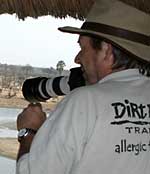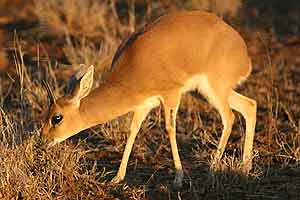Contact Details: Scotch Macaskill, Dirt Road Traders, Currys Post Road, Howick, KwaZulu-Natal, South Africa. Tel: +27 (0)82 578 2329. Privacy: Your privacy is guaranteed. See our Privacy Policy for more. This site accepts advertising and other forms of compensation - see Disclosure and Advertising for details. Site updated: 2022. Copyright © 2002 - 2022 Scotch Macaskill

| ||||||||||
|
||||||||||
|
SEE ALL |
Choosing a Wildlife Camera - the Digital SLR Option Although there are advantages to using a point-and-shoot digital camera with a
powerful zoom lens for wildlife photography (see The Superzoom Option),
the ideal wildlife camera remains the digital single lens reflex (digital SLR).
Although there are advantages to using a point-and-shoot digital camera with a
powerful zoom lens for wildlife photography (see The Superzoom Option),
the ideal wildlife camera remains the digital single lens reflex (digital SLR).
Not only is the image quality better, but you have more flexibility in choice of lenses, camera settings, and additional accessories. Image quality is better because the bigger sensor on a digital SLR has more light-gathering area and will produce images with less noise, particularly at the higher ISO settings often needed for taking wildlife pictures in early morning or late afernoon light. When you ramp up the ISO setting on your digital camera to make it more sensitive to light, you're also amplifying the noise. So noise is more visible at higher ISO's (just as grain is more visible on higher ISO film). Lens Choices Although zoom lens technology has improved greatly in recent years, it's not disputed that "prime" lenses of fixed focal length produce images of the best quality. It's no coincidence that the world's leading wildlife photographers will have a range of prime telephoto lenses in their arsenal - typically a 300mm F2.8 and either a 500mm F4 or 600mm F4 - in addition to top-of-the-range zooms like the 70-200mm F2.8. If your bank balance will allow, you can arm yourself with a selection of lenses that offers a much wider array of photographic options than any fixed-lens camera can offer. And even if you don't have unlimited funds, an entry-level digital SLR like one of the Canon EOS Digital Rebels with a couple of lenses will always be capable of producing higher quality images than your fixed lens camera. A very satisfactory "starter" camera outfit for wildlife photography would be a Canon EOS Rebel XTi (400D) with an 18-55 IS lens for scenic shots and a 70-300mm IS lens for telephoto use. Similar combinations from other major brands like Nikon, Pentax, Sony and Olympus are also available. A major advantage of digital SLRs for wildlife photography is that you can build your collection of lenses and accessories over time. So taking the above scenario, you could upgrade the lenses to include one or two prime lenses or better quality zooms with wider maximum apertures. You have the additional option of buying lenses from independent lens manufacturers like Sigma or Tamron. Once you have the lenses you want, you could upgrade the camera body or add a second, back-up body. In this way it's possible to gradually build up an entire system of photographic gear that suits your needs for wildlife and safari photography. Lenses designed for film or digital SLR cameras retain their value much better than do fixed-lens cameras. The latter are constantly being replaced by later models, making the earlier ones obsolete so there's little resale value. Lens technology on the other hand doesn't change as rapidly so there's always a demand for good quality used lenses. This also provides an opportunity to acquire a "must-have" lens that would be beyond your budget if bought brand new. See Canon Telephoto Lenses, Canon Zoom Lenses and Canon Wide Angle Lens for further information about Canon lenses for digital SLR cameras. The Mysterious "Crop Factor" It's important to remember that, unless you're using a very expensive full-frame DSLR, the entry-level and "prosumer" digital SLRs have a crop factor which is advantageous to wildlife photographers. Because the sensor or chip on these cameras is smaller in area than a 35mm negative, the edges around the image are cropped, so the lens appears to have a longer focal length. It's similar to using a 1.4x or 1.5x converter on a 35mm SLR camera, where you increase the magnification by 40% or 50%. It's similar, but not the same. With an optical converter, you're increasing the focal length of the lens and in the process the lens admits less light, so you lose an F stop (or two F stops with a 2x converter). Thus a 300mm F4 lens with a 1.4x converter becomes a 420mm F5.6 lens (300 x 1.4) on a normal 35mm film camera. The identical lens - 300mm F4 - when attached to a Canon 40D with its 1.6 crop factor gives you the same image magnification as would a 480mm on a 35mm film camera or full-frame Canon 5D - but without sacrificing that F stop. In fact the Canon 300mm F4 is a great lens for wildlife photography, specially when coupled
with a 1.4x converter.
When you add the converter and use it with a Canon digital SLR like the Rebel XTi or EOS 40D, it's like using a 672mm F5.6 lens (300mm plus 1.4x converter = 420mm, plus 1.6 crop factor = 672mm). It was just such a set-up that allowed me to fill the frame of my EOS 400D with the little steenbok grazing quite some distance from the road (right). The downside of the crop factor is that you need very wide angle lenses to take true wide angle shots, but this is more relevant to landscape and architectural photography than to wildlife photography.
The crop factor can be confusing and much has been written about it. It's best not to worry about the how's and
why's and be grateful that your digital SLR offers the extra reach that's so useful on a camera used for wildlife.
If you want to find out more, see:
I know that if I take a picture of a cheetah that fills the frame of my Canon DSLR using a 300mm lens, I'd have to use a 480mm lens on my old Canon EOS film camera to get the same photo. I also know that, because my 300mm lens is acting like a 480mm, I have to keep the camera as steady as if I was using a 480mm lens to avoid camera shake. And that's it - I don't concern myself about why this is happening. A "Family" of Accessories Digital SLRs are usually part of a "family" of sophisticated camera gear - from flashes to battery grips and remote releases - that isn't available for a point-and-shoot camera. This again gives you more flexibility, more options, including specialist lenses for macro and close-up photograpy. The main disadvantage of SLRs compared to point-and-shoot cameras is the cost, plus size and weight. Although the entry-level digital SLR bodies are remarkably compact, once you add a battery pack and a big lens, the unit becomes quite bulky and heavy. Include some additional lenses and a flash and you now need a fairly large and robust camera bag to carry and store your gear. But for anyone serious about wildlife photography, the SLR route is the only way to go because of the improved image quality and greater flexibility - even if it means starting with a used body and lens. You can always add to your "starter" wildlife camera outfit as finances permit. Below are some of the more popular digital SLR cameras suitable for wildlife and safari photography compiled at the time this article was written. Please do note that manufacturers regularly update and upgrade their cameras, so it's likely there are newer versions now available.
Article by Scotch Macaskill © Return to Photo Info page for more photography articles. |
|||||||||
|
|
||||||||||
